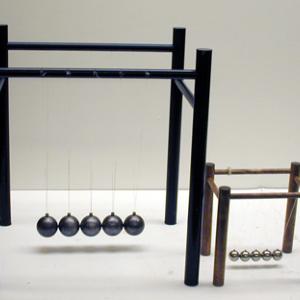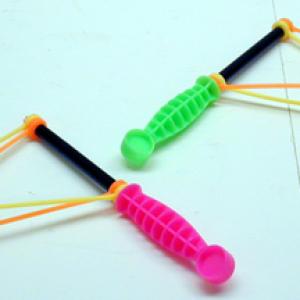College of Liberal Arts & Sciences
1N30.10 - Newton Spheres, Clackers
The Newton Spheres may have to be adjusted to maintain proper alignment. Try not to bounce them around to much when moving as this may stretch the strings. The magnetic Newton's cradle apparatus can be used to show oscillations with small losses in energy. Also the magnets may be turned to different orientations for different effects.
- Paul Hewitt, "Figuring Physics", TPT, Vol. 60, #7, Oct. 2022, p. 621.
- Barbara Rovsek, Saso Zigon, "Collisions of Coins", TPT, Vol. 59, #8, Nov. 2021, p. 639.
- Robert Uccelli, "BIG Physics", TPT, Vol. 50, #6, Sept. 2012, p. 376.
- Rod Cross, "Edme Mariotte and Newton's Cradle", TPT, Vol. 50, #4, Apr. 2012, p. 206.
- Michael Paesler, "A Better 2-D Mechanical Energy Conservation Experiment", TPT, Vol. 50, #2, Feb. 2012, p. 109.
- David Kagan, "Happy Balls, Unhappy Balls, and Newton's Cradle", TPT, Vol. 48, #3, Mar. 2010, p. 152.
- Iain MacInnes, "Debouncing a Superball", TPT, Vol. 45, #5, May 2007, p. 304.
- Hasan Fakhruddin, "Maximizing Imparted Speed in Elastic Collisions", TPT, Vol. 41, #6, Sept. 2003, p. 338.
- Pere Roura, "Collisions Between Rods: A Visual Analysis", TPT, Vol. 41, #1, Jan. 2003, p. 32.
- David Kagan and Chris Gaffney, "Colliding Magnetic Pendula: When Is a Collision Not Collision-Like?", TPT, Vol. 40, #5, May 2002, p. 280.
- Colin Gauld, "Using Colliding Pendulums to Teach Newton's Third Law", TPT, Vol. 37, #2, Feb. 1999, p. 116.
- J. D. Gavenda and J. R. Edgington, "Newton's Cradle and Scientific Explanation", TPT, Vol. 35, #7, Oct. 1997, p. 411.
- Robert Ehrlich, "Experiments with Newton's Cradle", TPT, Vol. 34, #3, Mar. 1996, p. 181.
- Herman Erlichson, "Newton's Strange Collisions", TPT, Vol. 33, #3, Mar. 1995, p. 169.
- Martin Gardner, "The Puzzling Quarters", TPT, Vol. 30, #8, Nov. 1992, p. 509.
- Subagyo and Ed van den Berg, "Momentum, Waves, and Money", TPT, Vol. 30, #8, Nov. 1992, p. 509.
- Jay S. Heubner, "Modifying Newton's Yo-Yo", TPT, Vol. 29, #3, Mar. 1991, p. 134.
- H. Richard Crane, "Newton's Yo-Yo, a Square Sprinkler, and a Disposable Battery Tester", TPT, Vol. 28, #8, Nov. 1990, p. 569.
- Easton, "Response", TPT, Vol. 26, #6, Sept. 1988, p. 329.
- Robert P. Bauman, "Fly Physics", TPT, Vol. 26, #6, Sept. 1988, p. 328.
- D. Easton, "Can a Fly Stop a Train?", TPT, Vol. 25, #6, Sept. 1987, p. 374.
- Joe Pizzo, "Bowling Ball Impact Apparatus",TPT, Vol. 25, #1, Jan. 1987, p. 40.
- Richard B. Minnix and D. Rae Carpenter, Jr., "Apparatus for Teaching Physics", TPT, Vol. 22, #4, Apr. 1984, p. 258.
- F. D. Becchetti and A. Dockrill, "Collision Balls and Coupled Pendulums for the Overhead Projector", TPT, Vol. 22, #4, Apr. 1984, p. 258.
- R. D. Edge, "Linear Dynamic with Marbles", TPT, Vol. 17, #3. Mar. 1979, p. 200.
- Bob Kimball, "Two New Experiments", TPT, Vol. 11, #6, Sept. 1973, p. 353, also A Potpourri of Physics Teaching Ideas - Odds and Ends, p. 322.
- Rod Cross, "Newton's Cradle with Two Balls", TPT, Vol. 61, #4, Apr. 2023, p. 260.
- R. Hessel, A. C. Perinotto, R. A. M. Alfaro, and A. A. Freschi, "Force-Versus-Time Curves During Collisions Between Two Identical Steel Balls", AJP, Vol. 74, #3, Mar. 2006, p. 176.
- Stefan Hutzler, Gary Delaney, Denis Weaire, and Finn MacLeod, "Rocking Newton's Cradle", AJP, Vol. 72, #12, Dec. 2004, p. 1508.
- David Auerbach, "Colliding Rods: Dynamics and Relevance to Colliding Balls", AJP, Vol. 62, #6, June 1994, p. 522.
- Ian Bruce, "A One-Dimension Collision Experiment", AJP, Vol. 58, #7, July 1990, p. 696.
- S. K. Bose, "Remarks on a Well-Known Collision Experiment", AJP, Vol. 54, #7, July 1986, p. 660.
- F. Herrmann and M. Seitz, "How Does the Ball-Chain Work?", AJP, Vol. 50, #11, Nov. 1982, p. 977.
- F. Herrmann and P. Schmalzle, "Simple Explanation of a Well-Known Collision Experiment", AJP, Vol. 49, #8, Aug. 1981, p. 761.
- Mg-1, Freier and Anderson, A Demonstration Handbook for Physics.
- M- 582, "Marbles on Aluminum Track", DICK and RAE Physics Demo Notebook.
- M - 586, "Pendulation Toy - 3 to 1 Mass", DICK and RAE Physics Demo Notebook.
- M15-a, Wallace A. Hilton, Physics Demonstration Experiments.
- Bill Franklin, "Newton's Cradle", Teaching About Impulse and Momentum, p. 4.15.
- Bill Franklin, "Newton's Cradle and Scientific Explanation", Teaching About Impulse and Momentum, p. 2.16.
- Bill Franklin, "Newton's Cradle", Teaching About Impulse and Momentum, p. 23.
- George M. Hopkins', "Collision Balls", Experimental Science, Volume Two, p. 108.
- Jodi and Roy McCullough, "Conservation of Energy and Momentum with Click Sticks", The Role of Toys in Teaching Physics, p. 4.84.
- Jodi and Roy McCullough, "Energy and Momentum with a Newton's Cradle", The Role of Toys in Teaching Physics, p. 4.92.
- Martin Gardner, "Puzzling Quarters", Science Tricks, p. 38.
- Martin Gardner, "Penny Poser", Entertaining Science Experiments with Everyday Objects, p. 96.
- Janice VanCleave, "82 ,Thump!", Teaching the Fun of Physics, p. 123.
- Jearl Walker, "1.42, Chain Collisions", The Flying Circus of Physics Ed. 2, p. 20.
- Julien Clinton Sprott, Physics Demonstrations, "1.12, Collision Balls", ISBN 0-299-21580-6, p. 32.
- Gerard L'E Turner, "Nineteenth-Century Scientific Instruments", p. 76- 77.
- Janice VanCleave, "Bonk!", 201 Awesome, Magical, Bizarre, & Incredible Experiments, p. 97.
- Robert Ehrlich, "Coefficient of Restitution", Why Toast Lands Jelly-Side Down, p. 93- 96.
- "245, Executive Toy: Newton's Cradle", Christopher P. Jargodzki and Franklin Potter, Mad About Physics, p. 97, 235.
- Brown, "Wave Transmission", 200 Illustrated Science Experiments for Children, p. 38- 39.
- Curt Suplee, "Can't stop on a dime", Everyday Science Explained, National Geographic, p. 26.
- Borislaw Bilash II, “Newtonian Demonstrator“, A Demo A Day – A Year of Physical Science Demonstrations, p. 246.
- Julius Sumner Miller, Q82 & A82, Millergrams I – Some Enchanting Questions for Enquiring Minds, p. 53 & 105.
- Joseph Frick, "#123 - Impact", Physical Technics: Or, Practical Instructions for Making Experiments in Physics and the Construction of Physical Apparatus with the Most Limited Means", p. 150.
- "Collision Balls for Action and Reaction", Pike's Illustrated Catalogue of Scientific & Medical Instruments, 1984, p. 143.
Disclaimer: These demonstrations are provided only for illustrative use by persons affiliated with The University of Iowa and only under the direction of a trained instructor or physicist. The University of Iowa is not responsible for demonstrations performed by those using their own equipment or who choose to use this reference material for their own purpose. The demonstrations included here are within the public domain and can be found in materials contained in libraries, bookstores, and through electronic sources. Performing all or any portion of any of these demonstrations, with or without revisions not depicted here entails inherent risks. These risks include, without limitation, bodily injury (and possibly death), including risks to health that may be temporary or permanent and that may exacerbate a pre-existing medical condition; and property loss or damage. Anyone performing any part of these demonstrations, even with revisions, knowingly and voluntarily assumes all risks associated with them.


